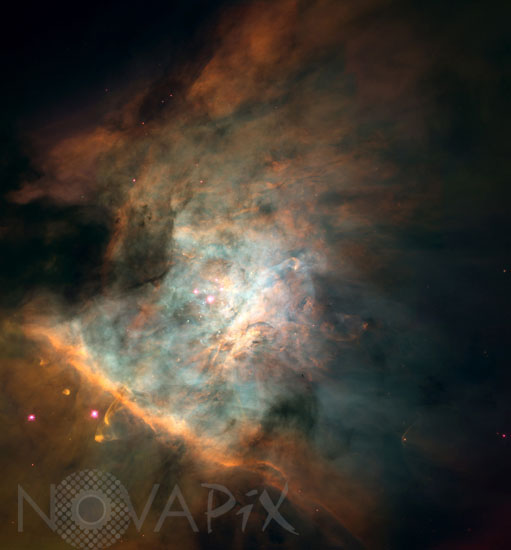Photo Agency - Astronomy - Space - Nature

Orion nebula center
author: Nasa/Novapix
reference: a-neb19-76110
Image Size 300 DPI: 23 * 24 cm
The picture shows a churning turbulent star factory set within a maelstrom of flowing,luminescent gas. Though this 2.5 light-years wide view is still a small portion of the entire Orion nebula, it includes almost all of the light from the bright glowing clouds of gas and a star cluster associated with the nebula. Hubble reveals details as small as 4.1 billion miles across. Hubble Space Telescope observing time was devoted to making this panorama because the nebula is a vast laboratory for studying the processes which gave birth to our own Sun and solar system 4.5 billion years ago. Gas are illuminated and heated by a torrent of energetic ultraviolet light from its four hottest and most massive stars, called the Trapezium, which lie near the center of the image. In addition to the Trapezium, this stellar cavern contains 700 hundred other young stars at various stages of formation. High-speed jets of hot gas spewed by some of the infant stars send supersonic shock waves tearing into the nebula at 100,000 miles per hour. These shock waves appear as thin curved loops, sometimes with bright knots on their end (the brightest examples are near the bright star at the lower left). The mosaic reveals at least 153 glowing protoplanetary disks (first discovered with the Hubble in 1992, and dubbed "proplyds") that are believed to be embryonic solar systems that will eventually form planets. (Our solar system has long been considered the relic of just such a disk that formed around the newborn Sun). The abundance of such objects in the Orion nebula strengthens the argument that planet formation is a common occurrence in the universe. The proplyds that are closest to the Trapezium stars (image center) are shedding some of their gas and dust. The pressure of starlight from the hottest stars forms "tails" which act like wind vanes pointing away from the Trapezium. These tails result from the light from the star pushing the dust and gas away from the outside layers of the proplyds. In addition to the luminescent proplyds, seven disks are silhouetted against the bright background of the nebula. These dark objects allow Hubble astronomers to estimate the masses of the disks as at least 0.1 to 730 times the mass of our Earth. Located 1,500 light-years away, along our spiral arm of the Milky Way,the Orion nebula is located in the middle of the sword region of the constellation Orion the Hunter, which dominates the early winter evening sky, at northern latitudes. The stars have formed from collapsing clouds of interstellar gas within the last million years. The most massive clouds have formed the brightest stars near the center and these are so hot that they illuminate the gas left behind after the period of star formation was complete. The more numerous faint stars are still in the process of collapsing under their own gravity, but have become hot enough in their centers to be self luminous bodies. Technical information: To create this color mosaic, 45 separate images of the Orion nebula were taken in blue, green and red filters between January 1994 and March 1995. Light emitted by oxygen is shown as blue,hydrogen emission is shown as green, and nitrogen emission as red light. The overall color balance is close to that which an observer living near the Orion nebula would see.
Contact : Stéphane Aubin +33-(0)9-51-26-53-76
© Novapix - All rights reserved


